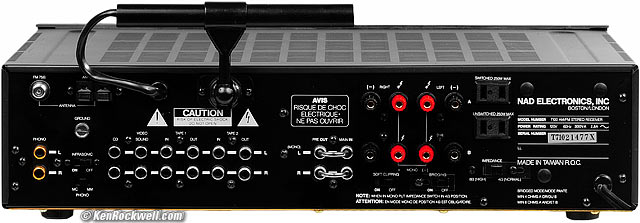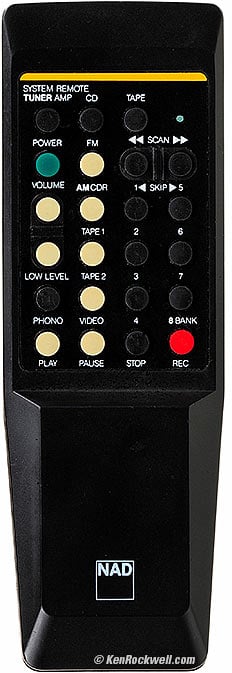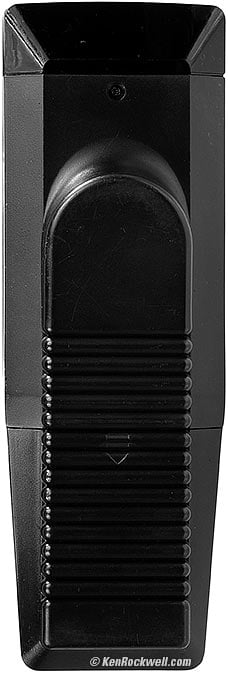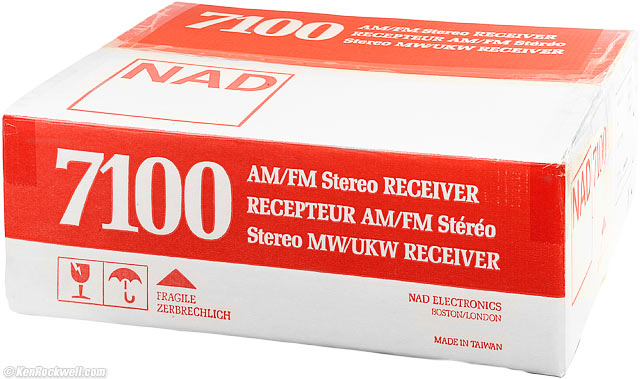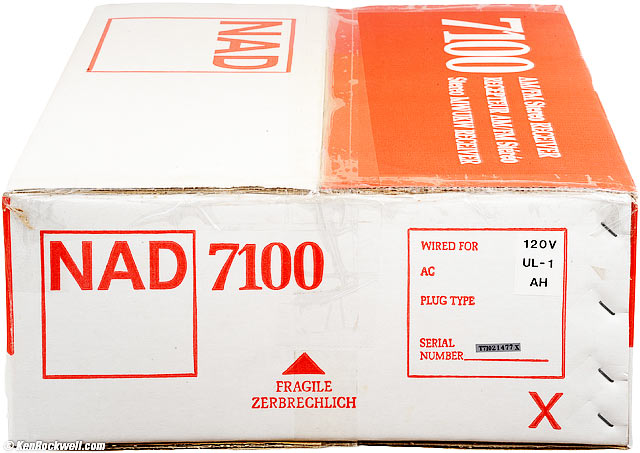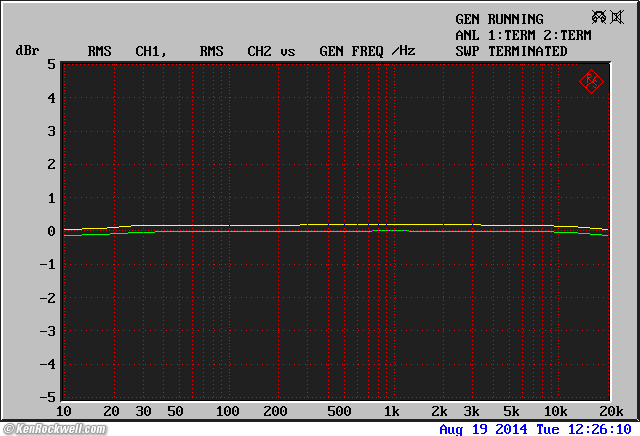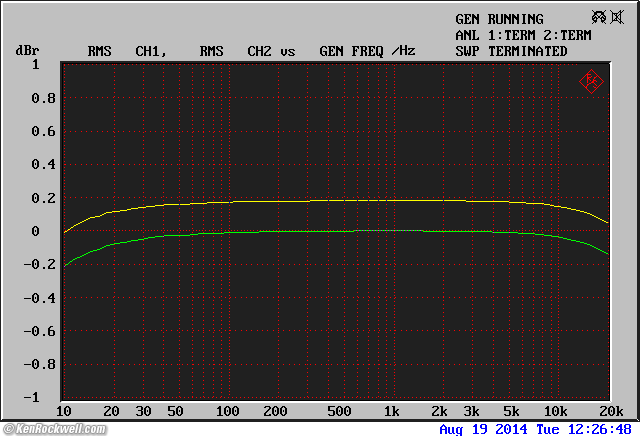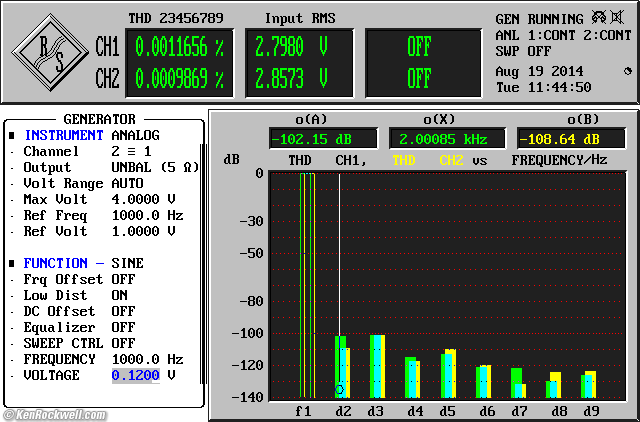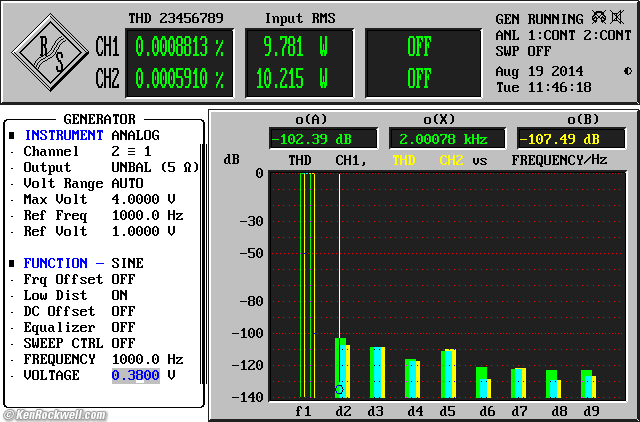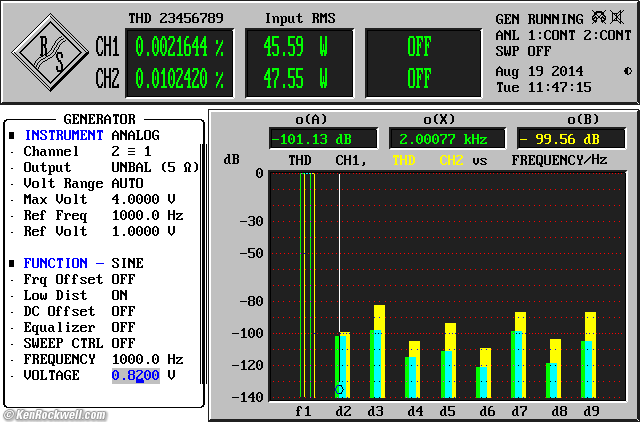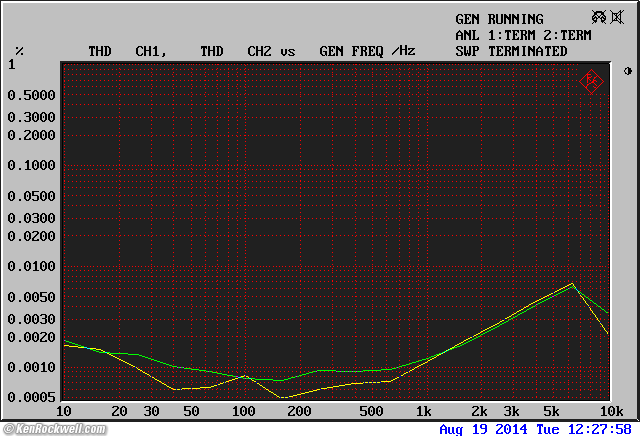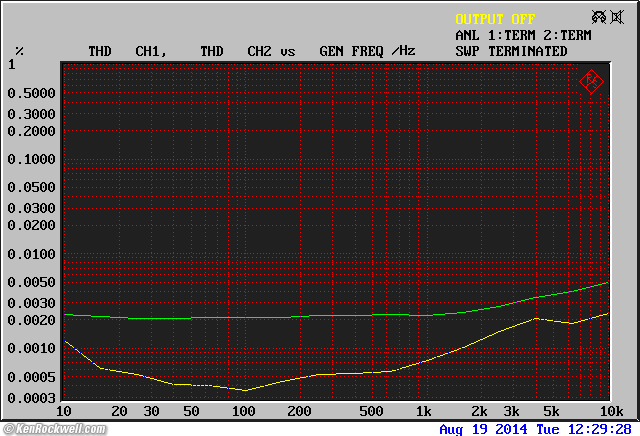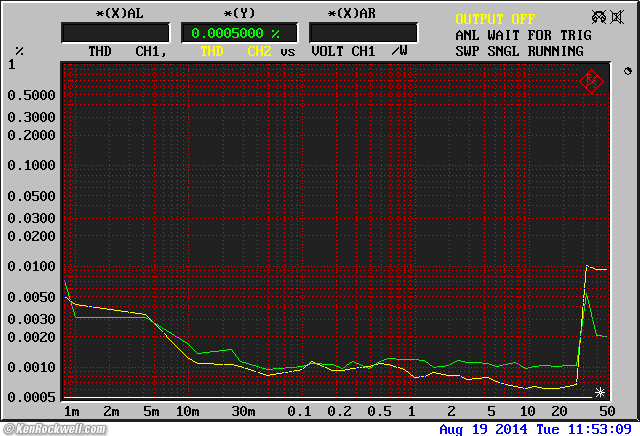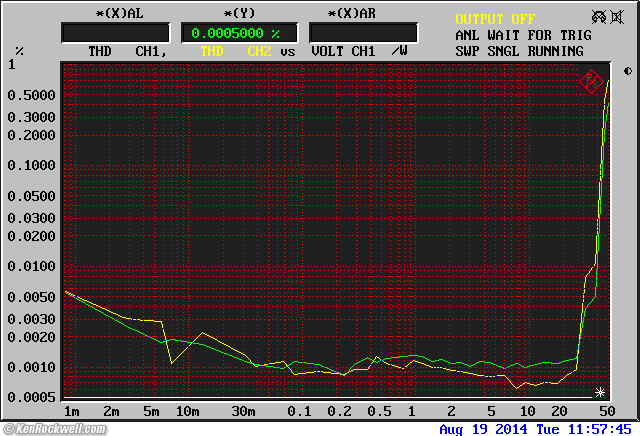Home Donate New Search Gallery Reviews How-To Books Links Workshops About Contact
NAD 7100 and 7100X
Monitor Series AM/FM Stereo Receiver (1988-1993)
© 2014 KenRockwell.com. All rights reserved.
Intro Specifications Measurements Compared
NAD 7100 (rated 60 watts per channel into 8Ω, 221 W actual measured clean burst power, 18 lbs./8.2 kg, measured 33 watts idle power draw, about $150 used). enlarge. I got this mine at this link directly to them at eBay (see How to Win at eBay).
This free website's biggest source of support is when you use those or any of these links to approved sources when you get anything, regardless of the country in which you live — but I receive nothing for my efforts if you take the chance of buying elsewhere. I get no government hand-outs and run no pledge drives to support my research, so please always use any of these links to approved sources for the best prices, service and selection whenever you get anything. Thanks for helping me help you! Ken.
Rear, NAD 7100. enlarge.
September 2014 NAD reviews audio reviews all reviews
Introduction top
Intro Specifications Measurements Compared
The NAD 7100 is a great-looking receiver that works as well as it looks. It originally was a relatively inexpensive receiver that used clever design and off-shore manufacturing to extract great sound out of an inexpensive package.
It has a plastic face and push-on plastic knobs. No set screws here!
The remote control is much more legible than others, and it's designed so that the infrared LEDs shine out the bottom as well as the front, so you can point the bottom or the front at the receiver as you read the buttons.
NAD Monitor System remote control. enlarge.
There are LEDs on the remote control to let you know it's transmitting, and another LED on the front face of the NAD 7100 to let you know it's receiving. Brilliant!
The green power button is a short-throw click-click button that tells the computer to turn the power really on or off. It's not a bigger switch actually handling the power itself as in older equipment.
The FM tuner has an IF NARROW position to increase selectivity to allow receiving weak stations that are normally covered by stronger local stations.
The FM tuner tunes in 50 kHz steps, so you have to press the TUNE buttons four times to go from one channel to the next in manual tuning. There are also three vestigial center-tune LEDs, which may have made sense in the late 1980s when this was probably the first digitally tuned receiver someone had purchased, while everyone today knows you don't really need to "tune in" a digital FM tuner. One advantage of this can be to let you tune away slightly from a strong local station in favor of an adjacent weak station - but today in 2014 where different stations play the same thing and the same stations repeat themselves all over the band with translators in different locations, who cares? Back in the 1980s radio stations were still different, and not all playing the same online feeds as they are today.
The AM tuner sounds crisper than most others. It has a slightly extended high frequency response. It's also reasonably resistant to interference, and very resistant to problems from IBOC HD Radio interference
The 5-LED signal strength meter works great on both FM and AM. It will read lower than useless meters that usually read full-scale all the time. When it reads 3 out of 5, you've got a good signal. 4 is very good, and 5 is excellent. 2 is OK, 1 is getting weak, and none is weak.
There are no overload lights for the power amplifier. NAD has all sorts of crazy soft clipping and
There are loads of lights on the front panel when playing the radio, but only one or two LEDs lit when playing other inputs. All the tuner lights extinguish if you're not listening to it.
Circuit Design
As I understand it, it uses a class AB power amplifier, but adds a second switchable "commutating" power supply rail to let it deliver more power for short bursts. This is why it's only rated at 50W, but puts out over 200W on bursts.
This is good because music only needs short bursts of high power, but bad if you make a point of hitting the amp hard, since it can overheat or start distorting after a few seconds. If you hit the amp this hard for long periods of time, just get a bigger amplifier, while for all reasonable home uses, this clever configuration lets one get all of the high power, but without the expense, heat and weight of bigger amplifiers.
It uses speaker relays and a 7-second turn-on delay for smooth operation.
Timeline
1987
NAD introduces the top-of-the-line Monitor Series 7600 receiver. it's rated at 150 WPC with 4 dB IHF headroom at a list price of $1,498.
There are optional rack handles with red accents, which are the hallmarks of this series of components.
1988
NAD introduces the 7400 and this 7100 receiver, which are lesser models in the same series to fill in below the 7600.
The 7400 has selectable turnovers for the tone controls and is rated at 100 WPC with 6.2 dB of IHF headroom for $1,098 list price. It has a metal faceplate.
This 7100, with a plastic faceplate, is rated at 50 WPC with 6.6 dB of IHF headroom (230 W) and has a list price of $748.
Since NAD now has lower priced receivers available with the 7100 and 7400, they took this opportunity to raise the list price of the 7600 to $1,598.
1989
The 7100 is now listed at $749, the 7400 drops to $999 and the 7600 stays at $1,599.
The 7400 is seen on the cover of Audio's October issue.
1990
NAD introduces a 7000 with 40 WPC and 6 dB IHF headroom for $579 list price.
The 7100 is updated to the 7100X, now rated with 60 WPC but with only 6 dB IHF headroom (240 W), for $749 list.
I'm unsure how to identify a 7100X. Some say it's the final X in the serial number and not marked as such on the front panel, but considering that it was a real product marketed and sold as the 7100X as an update to the older 7100, it should have been marked as "7100X" on the front and rear panels. I haven't seen enough of these to confirm.
The 7400 stays at $999, and the 7600 is gone.
1991
The 7000 is $579, the 7100X is $749 and the 7400 is $999, list prices.
1992
The 7100X is $749.
The others are gone, leaving the 7100X as NAD's top receiver.
1993
The 7100X is $749, again as NAD's top receiver
1994
The 7100X is gone, replaced by the 5-channel 716 at the same $749 list.
For stereo, the best NAD receiver becomes the 705 at $499, left over from previous years.
Specifications top
Intro Specifications Measurements Compared
See the NAD 7100 product page and NAD 7100 User's Manual.
Output Power
It's rated 60 WPC continuous, and 200 WPC burst into 8Ω.
It's rated for 250 WPC burst power into 4Ω and 330 WPC burst power into 2Ω. That's where they get the 330W number for the sticker.
Bridged mono mode rated 100 W continuous and 500 W burst power into 8Ω. Mono burst power into 4Ω is rated 660 W.
FM
87.5 ~ 108.0 MHz in 50 kHz steps.
Normal and narrow IF bandwidths.
AM
520 ~ 1710 kHz in standard 10 kHz steps.
Only one default bandwidth.
Quality
Made in Taiwan.
Packaging
Corrugated cardboard box.
Amplifier supported by expanded polystyrene end caps.
Size
4.17 x 17.1 x 15.35 inches (106 x 435 x 390mm), HWD.
Weight
24.2 pounds (11 kg).
27.9 pounds (12.7 kg) shipping weight.
Price, USA
2014: about $150 used.
NAD 7100 box.
NAD 7100 box end.
Measurements top
Intro Specifications Measurements Compared
These measurements are made with an exotic Rohde & Schwarz UPL laboratory analyzer. The traces from the Rohde & Schwarz UPL laboratory analyzer are color coded for the Left Channel and for the Right Channel. When they don't lie on top of each other, it's due to channel imbalance. When they do lie on top of each other, the trace turns blue.
Unless otherwise specified, all measurements are RMS at 1 kHz.
Preamp measurements are with a 200 kΩ load at 1 V at unity gain from the CD input.
Power amp measurements are at 1 watt continuous output per channel at 1 kHz with an 8 Ω load, both channels driven.
I measured the power amp with an 8Ω resistor at the NORMAL (4Ω) setting. It would have put out more at the 8Ω setting.
These are 2014 measurements of a product built back in the 1980s.
Preamplifier
Input Levels Output Levels Gain
Channel Balance Channel Tracking
Frequency Response Filters Tone Loudness
Power Amplifier
Overall
Preamp Maximum Input Level measurements top
< 0.006% THD at 10 V RMS, CD input. Whatever input clipping is, my generator can't go there.
Preamp Maximum Output Levels measurements top
Normal: 9.894 V left, 10.303 V right, measured at 0.1% THD.
LOW LEVEL: 0.9271 V left, 0.9523 V right, measured at 0.1% THD.
Preamp Gain measurements top
Normal Level
16.723 dB left, 16.065 dB right.
With the pot halfway down, gain is 0.1725 dB left, -0.1936 dB right.
With the pot all the way down, gain is -95.3 dB left, -92.4 dB right.
Low Level
-3.905 dB left, -4.615 dB right.
With the pots halfway down, gain is -20.389 dB left, -20.823 dB right.
With the pot all the way down, gain is -114.7 dB left, -113.0 dB right.
Preamp Channel Balance measurements top
The right channel is about 0.4 dB dB lower than the left.
Preamp Channel Tracking top
![]()
Right channel level versus left channel, vs. volume control setting. (positive means image moves to right.)
The stereo image doesn't vary as the volume is changed.
This is better than it seems, since most of the error is a constant 0.4 dB difference in the preamp.
Poorer amplifiers often skew the stereo image several dBs or more at the lowest volume settings, while this NAD does a far better than average job.
Preamp Frequency Response measurements top
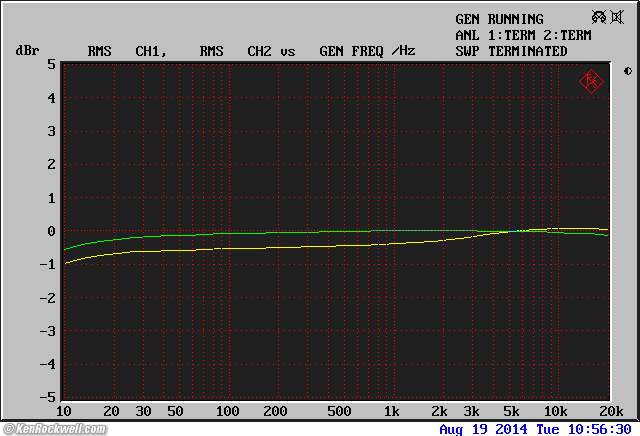
Preamp frequency response.
The right channel is about 0.4 dB lower than the left, but worse, the response is imbalanced in the right channel.
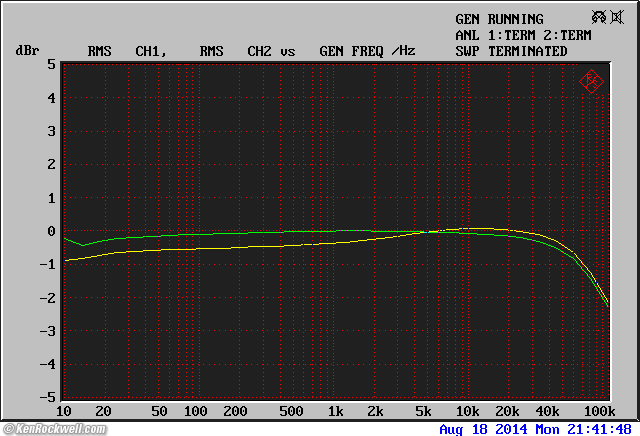
Preamp high-frequency response.
It's about -3 dB at 120 kHz, swell.
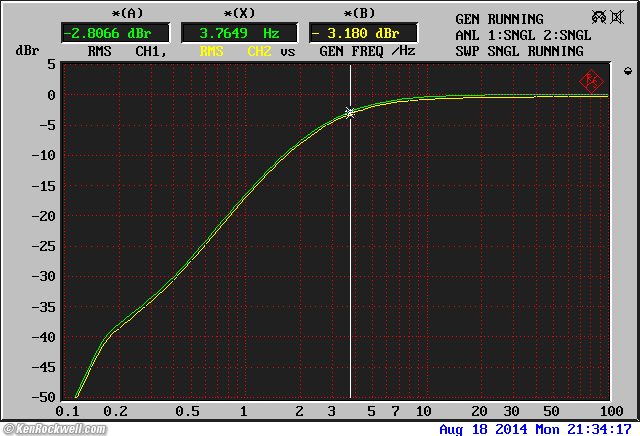
Preamp infrasonic frequency response, filter OFF.
It's -3 dB at 3.7 Hz, very good.
Preamp Filters Response measurements top
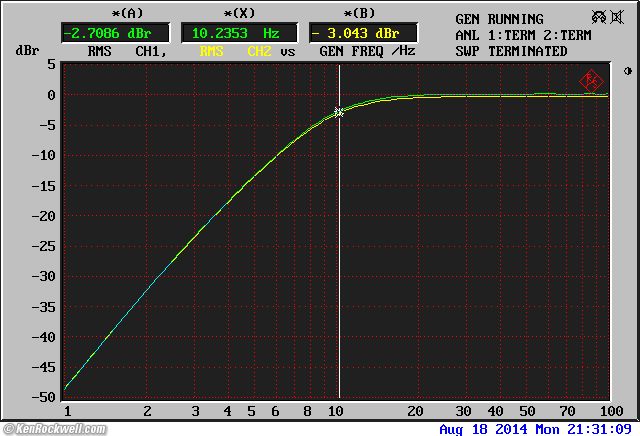
Preamp infrasonic filter frequency response (rear-panel infrasonic filter ON).
It's -3 dB at 10 Hz and rolls off at about 15 dB/octave. This is very good; it attenuates rumble and doesn't alter the lowest audible frequencies.
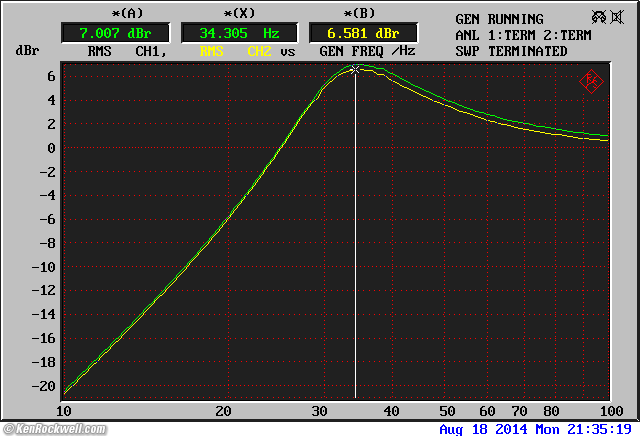
Preamp BASS EQ filter frequency response.
It's +6.5 dB at 34 Hz, 0 dB at 24 Hz and and rolls off at about 12 dB/octave below this. This does add some bass to most music; it's the same as the B&W Bass Alignment Filter set for the B&W Matrix 805.
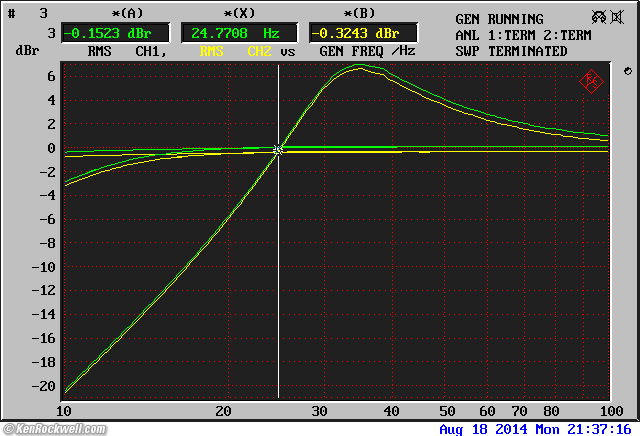
Preamp BASS EQ (peak), flat and infrasonic filter frequency responses.
This is a composite curve; you only get one response at a time.
The infrasonic filter has no additional effect with the BASS EQ active; it's as if either is the same filter with a different Q and Fc setting.
Preamp Tone Controls measurements top
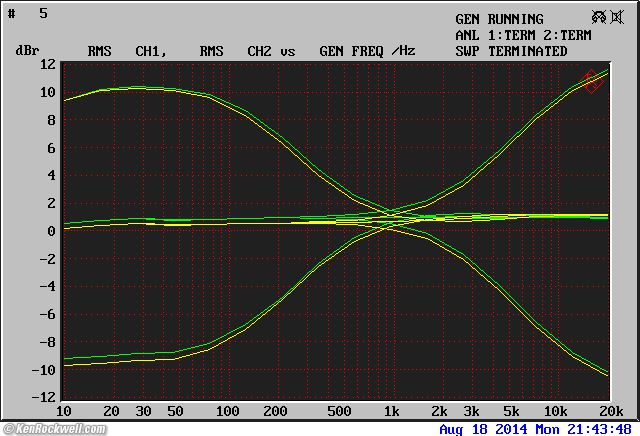
Preamp tone controls frequency response.
The tone controls are bush league. They affect too much of the mid range. They are designed to impress the innocent, but don't let us make the adjustments we really need as do the ADCOM GTP-500 II and Apt Holman Preamp.
With these tone controls, we can't adjust the deep bass or high treble without mucking up the upper bass or lower treble. The NAD 7400 has far better tone controls.
Preamp Loudness Control measurements top
The loudness control is also bush league. It boosts the treble, and boosts too much of the upper bass and not enough of the lower bass. It was designed to sell at retail, not to perform well at home.
For a better loudness control, again either of the ADCOM GTP-500 II or Apt Holman Preamp do it much better. (On the Apt preamp, use the bass control to taste at low listening levels.)
The contour is the same for the same position of the gain (volume) control. The LOW LEVEL switch has no effect; it lowers the level, while the boost depends only on the position of the knob, not the realized gain (level setting).
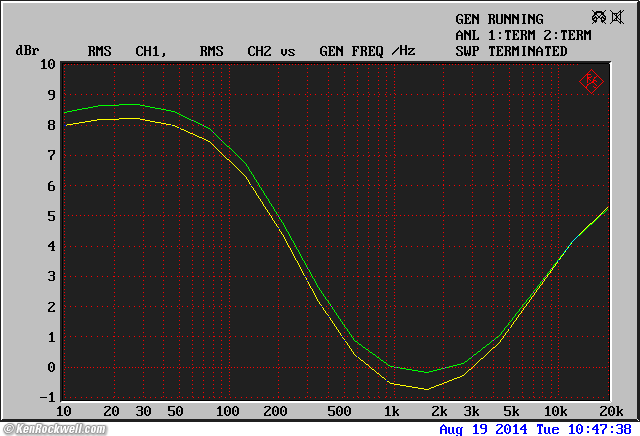
Preamp loudness frequency response at 9 o'clock.
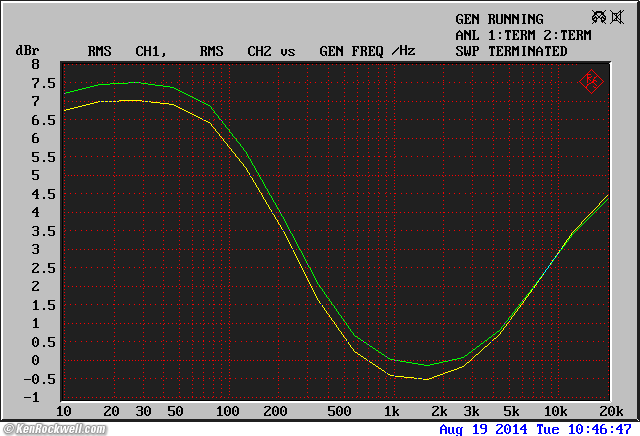
Preamp loudness frequency response at 10:30 o'clock.
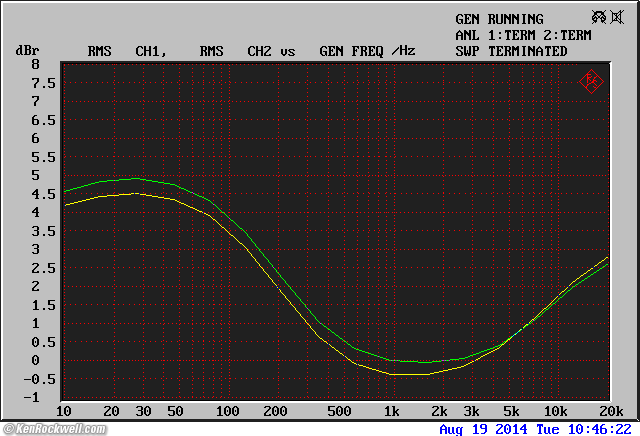
Preamp loudness frequency response at 12 o'clock.
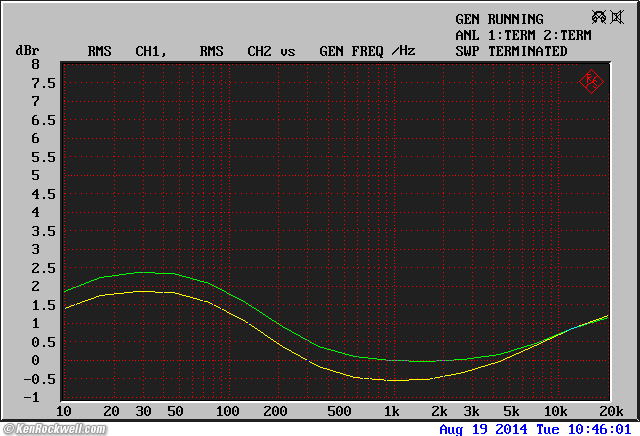
Preamp loudness frequency response at 1:30 o'clock.
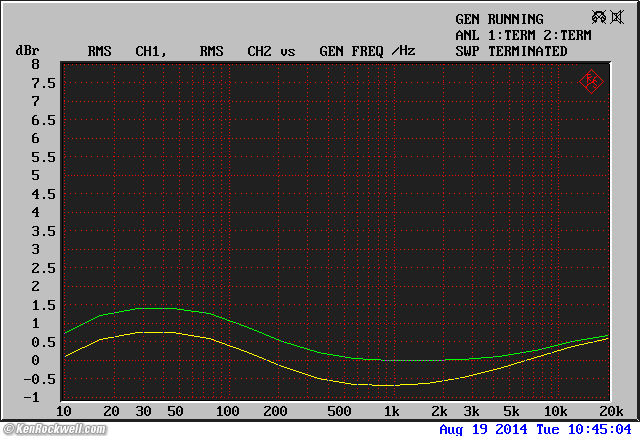
Preamp loudness frequency response at 3 o'clock and maximum (same response each setting).
Preamp THD measurements top
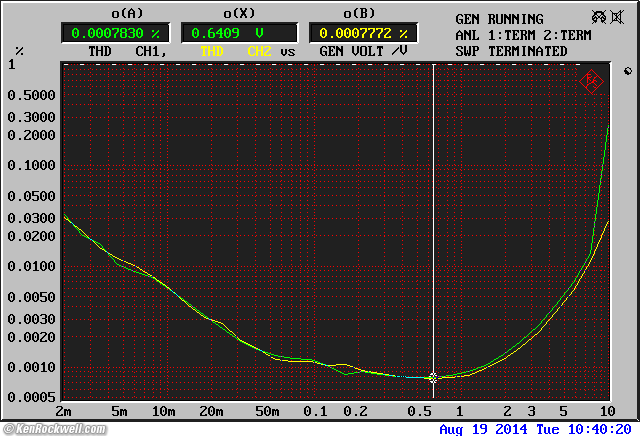
Preamp THD at 1 kHz.
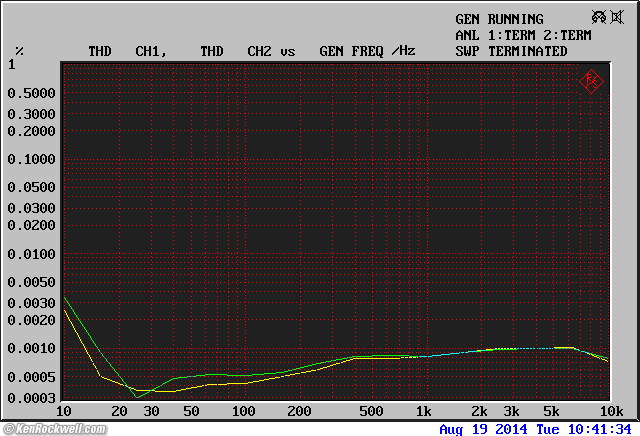
Preamp THD at 1 volt.
Preamp Output Noise measurements top
A Weighted |
Unweighted |
|
MIN |
-113.6 dBV A |
-110.6 dBV |
0 dB gain (12 o'clock) |
-108.3 dBV A |
-105.7 dBV |
MAX |
-100.8 dBV A |
-97.6 dBV |
LOW LEVEL |
A Weighted |
Unweighted |
MIN |
-118 dBV A |
-114.7 dBV |
12 o'clock |
-118 dBV A |
-114.7 dBV |
MAX |
-116.5 dBV A |
-113.1 dBV |
This is much quieter than average. The 7100 uses the smart variable-feedback gain control.
Phono Preamplifier measurements top
I measured the PHONO preamp at the TAPE 1 output. I drove it from the 5Ω source impedance of the R&S UPL.
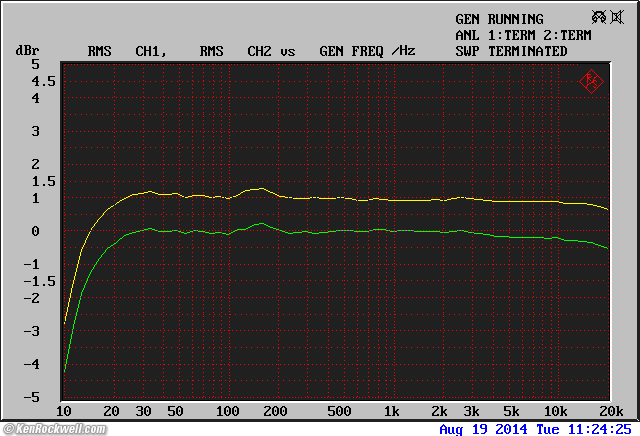
Phono preamp RIAA response. (same for moving magnet and moving coil positions.)
Moving Magnet
Gain at 1 kHz is 35.33 dB left, and 36.26 dB right channel.
A-weighted noise, with inputs terminated by the the 5Ω source impedance of the R&S UPL, measures -89.1 dBV left, -96.2 dBV right.
Maximum input level at 1 kHz is 200 mV which leads to 12 V at the tape output at 0.1% THD.
Moving Coil
Gain at 1 kHz is 58.07 dB left, and 58.98 dB right channel.
A-weighted noise, with inputs terminated by the the 5Ω source impedance of the R&S UPL, measures -66.3 dBV left, -75.1 dBV right.
Maximum input level at 1 kHz is 10 mV which leads to 8 V at the tape output at 0.1% THD.
Power Amp Gain measurements top
27.4 dB gain.
Gain climbs as it warms up.
Power Amp Channel Balance measurements top
The right channel is about 0.2 dB dB higher than the left. Since the preamp is 0.4 dB in the other direction, the integrated amp is about 0.2 dB lower in the left channel.
Power Amp Input Levels measurements top
120 mV for 1 W output.
830 mV gives 46 W output at steady-state clipping in 4Ω position.
1.03 V gives 70 W output at clipping for a few seconds in 4Ω position.
1.63 V in gives 180W 10 mS burst power at a PRF of 1 pps at 4Ω position.
990 mV gives 67 W output at steady-state clipping in 8Ω position.
1.13 V gives 85 W output at clipping for a few seconds in 8Ω position.
1.78 V in gives 221W 10 mS burst power at a PRF of 1 pps at 8Ω position.
Power Output measurements top
Continuous
67 watts per channel, both channels driven with 114 VAC power supply, no soft clipping, 8Ω position into 8Ω.
55 watts per channel, both channels driven with 114 VAC power supply, SOFT CLIPPING ON, 8Ω position into 8Ω.
46 watts per channel, both channels driven with 115.6 VAC power supply, no soft clipping, 4Ω position into 8Ω.
38 watts per channel, both channels driven with 115.6 VAC power supply, SOFT CLIPPING ON, 4Ω position into 8Ω.
Burst
Burst power at the point of visible clipping on an oscilloscope for 10 cycle (10ms) bursts at 1 kHz is 180 watts RMS with 118 VAC power line supply into 8Ω in 4Ω position. (53.75V peak at 1.63 V in.)
Burst power at the point of visible clipping on an oscilloscope for 10 cycle (10ms) bursts at 1 kHz is 221 watts RMS with 116 VAC power line supply into 8Ω in 8Ω position. (59.5V peak at 1.78 V in.)
Output Noise measurements top
A Weighted |
Unweighted |
-89 dBV A |
-87 dBV |
Signal to Noise Ratio (SNR) measurements top
98 dB A-weighted SNR (16.0 effective bits) referred to 1 watt into 8Ω (2.83 V or +9.031 dBV).
121.47 dB A-weighted SNR (19.9 effective bits) referred to 221 watts into 8Ω (42 V or +32.47 dBV).
Output DC Offset measurements top
-17.7mV left, -14.6 mV right.
Frequency Response measurements top
NAD 7100 frequency response into 8Ω.
7100 frequency response into 8Ω, expanded scale.
This is swell. The biggest problem is the 0.2 dB channel imbalance.
Power Amp THD: 0.001% (-100 dB) measurements top
All these THD measurements are measuring pure distortion components only (THD only), not noise and distortion (THD+N). THD+N numbers would be worse than THD alone shown here.
Harmonic Distortion Components at 1 watt
7100 harmonic distortion content at 1 W.
Perfect, mostly second and third harmonics.
Harmonic Distortion Components at 10 watts
7100 harmonic distortion content at 10 W.
Even better; mostly second harmonic.
Harmonic Distortion Components at 45 watts
7100 harmonic distortion content at 45 W.
At 46 watts it's almost clipping. Odd-order harmonics are prevalent.
Harmonic Distortion at 1 watt
NAD 7100 THD at 1 watt, 8Ω load.
Swell, nothing to hear here.
Harmonic Distortion at 45 watts
7100 harmonic distortion content at 45 W.
Even at close to clipping, nothing to hear here.
THD versus Power into 8 Ω
7100 THD versus power output at 1 kHz, 8Ω load, 4Ω position.
THD versus Frequency into 8 Ω
7100 THD versus power output at 1 kHz, 8Ω load, 4Ω position., SOFT CLIPPING.
As expected, SOFT CLIPPING starts distorting at lower levels than when it's off.
19+20 kHz Difference-Frequency Distortion (DFD)
per DIN IEC 268-3 or 118:
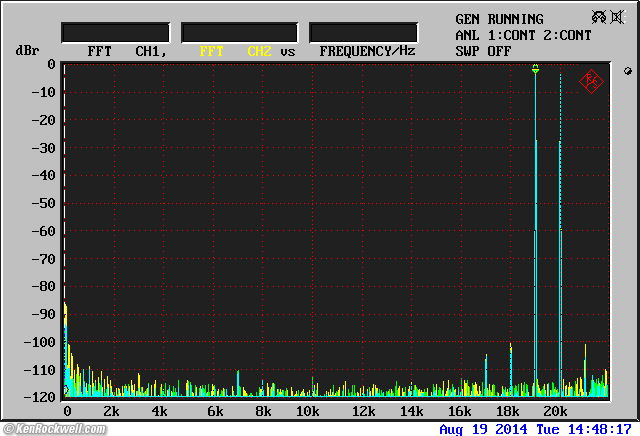
DFD at 1 W RMS total output.
The 1 kHz component is at -109 dB, which is superb.
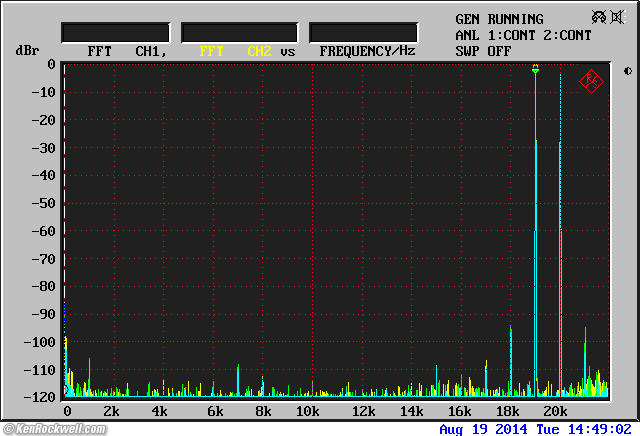
DFD at 10 W RMS total output.
The 1 kHz component is still at -105 dB, which is fantastic.
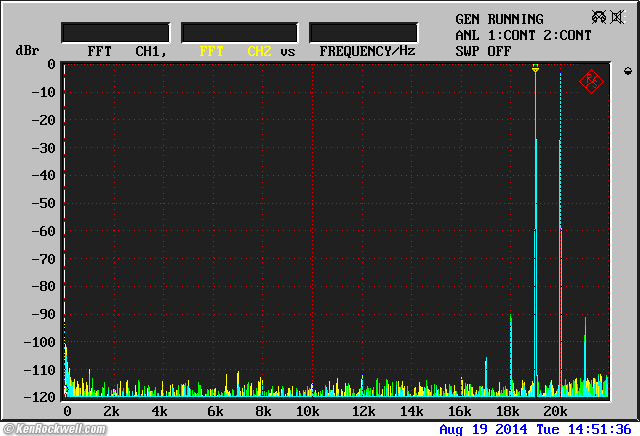
DFD at 25 W RMS total output.
The 1 kHz component is at -105 dB, which is the best I've measured at this level.
The close-in 18 kHz and 21 kHz skirts are at -90 dB, which are also magnificent at this high power level. At this level, your tweeters will blow in an instant so its not that critical.
System Gain measurements top
120 mV at the CD input produces 40 W output at the speakers at maximum gain.
Coincidentally, 120mV applied at the input of the power amplifier leads to 1 W output.
As rated, 19.4 mV at the CD input produces 1 W output at the speakers at maximum gain.
Measured Power Consumption measurements top
The 7100 runs mildly warm.
Output |
Power Consumption |
Efficiency |
Power off |
5.8 W |
0% |
Idle, no radio |
30.0 W |
0% |
Idle, radio |
35.5 W |
0% |
1 WPC |
52 W |
% |
67 WPC |
269 W |
% |
Compared top
Intro Specifications Measurements Compared
The 7100 is a smaller version of the 7400, which adds more power and selectable turnovers for the tone controls.
If you have your choice, the metal-faced 7400 is much better than the plastic-faced 7100 due to the superior tone controls and dreamy digital flywheel tuning knob.
Usage top
Intro Specifications Measurements Compared
Remote and Power
The receiver's power light is dim green in standby. It blinks as it receives remote commands.
LOW LEVEL is selected by default at power on. It lowers preamp output noise, too. If you want to play loud, you have to press the LOW LEVEL button to make it go away.
Often one has to hit the TUNER AMP button on the remote before it will make input selections. If you hit CD or TAPE, it alters the remote to talk to a NAD CD or Tape player and shared-purpose buttons won't talk to the receiver until you press TUNER AMP again. If it's not working, just press TUNER AMP and it will again.
Infrasonic filter and BASS EQ
INFRA switch on rear works for all. Oddly doesn't have any effect with bass EQ
Tuner
Scan scans when the Scan button is pressed in. Press it again, it pops out and tunes manually The remote's SCAN buttons really do the same as the receivers TUNE buttons; they tune or scan depending on the position of the receiver's SCAN button and you can't change that remotely.
To get the remote to talk to the tuner, you have to play Simon Says and press the TUNER remote button, and then the tuner buttons on the remote. For instance, unlike a B&O you can't just press a radio preset on the remote; you have to press POWER, TUNER (select a band) and then the preset.
7 buttons x 2 banks. Tally LED changes color with bank.
To save, select bank > press enter button > address
If you hit enter by accident, wait 10s or tune away or change band. Should cancel with second push, but doesn't.
Two week radio memory. May delete after a month.
Each memory location may be either AM or FM.
When you press the AM or FM band selectors, it recalls the station last used in that band, as well as remembering if it was from memory . Therefore if you're clever, the FM and AM buttons will switch the Memory Banks for you if you use one bank for AM and the other for FM.
Mono
The same button forces the FM tuner to mono, as well as anything going through the preamp.
Depending on how you have your selectors set, it may or may not force the Tape Output to mono.
Headphones
The headphone jack is always live, regardless of speaker selections. The output is simply the speaker outputs fed via a 220 Ω series resistor, and the power amp is so quiet that it's silent.
Recommendations top
Intro Specifications Measurements Compared
The 7100 is a great receiver. It's best virtues are styling as good as ADS or B&O, great, simple controls, a great remote, and a very closely tracking volume control. This is a product that actually works much better than brands designed in the Orient with controls and remotes with so many buttons that no one can ever get the music to play. With this NAD, it looks great, and it's easy to get the music on and tune the radio. It was designed in Belgium.
Since it separates into discrete power amplifier and preamplifier, you can integrate it into any sort of complex system. Technically, it sounds and tests very well.
For about $150 used today (see How to Win at eBay), most samples are pretty worn out. One this nice runs about $250.
The only troubles I had with mine is that the front panel buttons (including power) often were ignored. No worries, the remote works fine, but watch out for flaky push buttons.
I bought a second sample, and it was even worse. Its speaker relays never-pulled-in, so sound never came out.
If you get one for yourself, you'll have to be very careful to get one that actually works, and when you do, you'll love how easy it is to get your music to play.
More Information top
Intro Specifications Measurements Compared
Help me help you top
I support my growing family through this website, as crazy as it might seem.
The biggest help is when you use any of these links when you get anything, regardless of the country in which you live. It costs you nothing, and is this site's, and thus my family's, biggest source of support. These places have the best prices and service, which is why I've used them since before this website existed. I recommend them all personally.
If you find this page as helpful as a book you might have had to buy or a workshop you may have had to take, feel free to help me continue helping everyone.
If you've gotten your gear through one of my links or helped otherwise, you're family. It's great people like you who allow me to keep adding to this site full-time. Thanks!
If you haven't helped yet, please do, and consider helping me with a gift of $5.00.
As this page is copyrighted and formally registered, it is unlawful to make copies, especially in the form of printouts for personal use. If you wish to make a printout for personal use, you are granted one-time permission only if you PayPal me $5.00 per printout or part thereof. Thank you!
Thanks for reading!
Mr. & Mrs. Ken Rockwell, Ryan and Katie.
Home Donate New Search Gallery Reviews How-To Books Links Workshops About Contact

